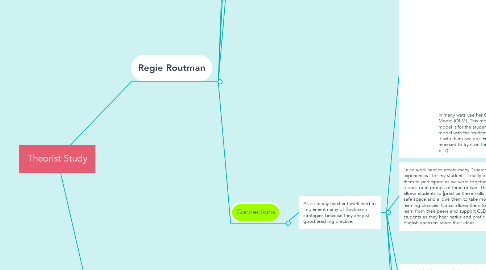
1. Regie Routman
1.1. Belief #1
1.1.1. It is essential to reflect, be mindful, and collaborate with colleagues in order to engage students, and bring excitement and energy into the classroom.
1.1.1.1. Theory
1.1.1.1.1. "Without thinking big, studying professionally, collaborating with colleagues, and being reflective and mindful about what's going well, what needs our attention and how do we best move forward, we will continue to end up on the usual educational treadmill - running in place without getting to a worthwhile destination" (Think Big, Think Smart, p. 29).
1.2. Belief #2
1.2.1. To ensure learners are successful, teachers need to engage students in culturally relevant, authentic content that allows learners to experience success.
1.2.1.1. Theory
1.2.1.2. "If we want students and teachers to put forth their best efforts with energy and enthusiasm, the work must be academically and culturally relevant, authentic in its content and form, directed to an audience and purpose that matters, and doable by the learner with minimal support" (Reflections, p. 4).
1.2.1.2.1. "...effective and sufficient demonstrations and shared experiences by an expert enable the learner to successfully "try and apply" what has been previously taught....Shared experiences are especially critical for second language leaners and learners who struggle" (p. 4-5).
1.3. Practice
1.3.1. Contribution to the Education Field
1.3.1.1. She has been in education for the past 40 years, and her writing encourages teachers to take control of their learning and create a learning environment the is fun and efficient.
1.3.1.1.1. She is well know for her current focus where she does residencies at schools. This allows her to work closely with schools for a week and enables her to have deep professional conversations, daily demonstrating teaching in classrooms, coaches teachers - which helps create change within the whole school.
1.4. Connections
1.4.1. As a literacy teacher I work hard to implement many of Routman's strategies because they are just good teaching practice.
1.4.1.1. In many wats use her Optimal Learning Model (OLM). This model allows me to model it for the student (I do). Then I model with the students and work through it with them (we do). Finally, students are released to try it on their own (Reflections, p. 7).
1.4.1.1.1. This type of model allows me to provide extra support to my students who struggle, it provides multiple opportunities for me to provide language support for my CLD students, and it allows me to check for understanding.
1.4.1.1.2. There is one area where I do not altogether agree with Routman, "...we notice and respond to their strengths as well as their weaknesses." (Reflections, p. 5). Though I identify areas where they may struggle, I am not found of the term "weakness." For me I focus on their strengths and how do build off of those because this automatically address areas where they struggle and provides the students with a sense of hope.
1.4.1.2. I also work hard to create many "shared experiences" for my students. I really push them to participate as we word together as a class or in groups of three or two. This allows students to [practice these skills in a safe space and allows them to take more learning chances. It also allows them to learn from their peers and support CLD students as they hear native and proficient English speakers share their ideas.
1.4.1.3. As a teacher I completely believe in working closely with my colleagues to collaborate and plan with.
1.4.1.3.1. I work, in particular, with one of the other literacy teachers at my school. Together we have accomplished something no other English Department in Westminster Public Schools has been able to do. Which is building a common curriculum together. Together we have created common assessments, common assignments, and a common learning progression. We work hard to create a learning experience that each class will enjoy, be able to relate to, have have components of authentic literacy.
1.4.1.4. When I started teaching this was pzrticlulary difficult for me because I wanted to be a good teacher. However, as I became more knowledgeable I realized that a good teachers means you are willing to try new things and be honest when something in your teaching practice needs to improve.
1.4.1.4.1. It actually reminds when when I was getting my initial teaching degree and one of my professors said, "when you do not think you have anything else to improve on in your teaching, then it is time to either retire or find a new job." This idea did not truly resonate with me until I started the CLD masters program at Regis.
1.4.1.5. Lastly, I think Routman is correct about reflecting on why we teach in a certain way, explore how an activity/lesson will contribute to students becoming more independent with their literacy skills, and how we know if our students are learning.
1.4.1.5.1. Asking questions about these things allows us to continually improve our practice and curriculum, and part of the battle is being honest with ourselves when something is not working or when something went bad.
2. References
2.1. Routman, R. (2014). Think big, teach smart. Heinemann. Retrieved from https://www.heinemann.com/pd/journal/think big_routman.pdf
2.1.1. Routman, R. (2011). Reflections on literacy teaching and learning. Reading Manitoba, 32(1), 4–7. Retrieved from https://www.regieroutman.org/files/9613/4575/2891/Manitoba_Reading_RR_article.pdf
2.1.1.1. Routman, R. (2002, March). Teacher talk. Educational Leadership, 59(6), 1–4.
